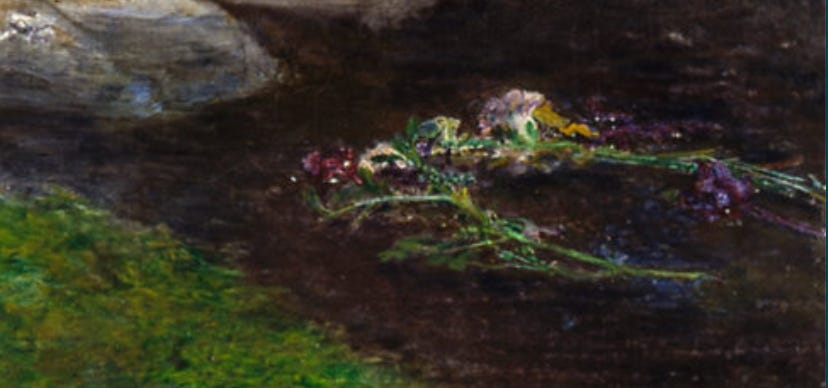The Language of Ophelia's Flowers
Exploring Millais’ Ophelia using the language of flowers of the Victorian and Elizabethan eras
There is a willow grows askant the brook,
That shows his hoar leaves in the glassy stream.
There with fantastic garlands did she make
Of crowflowers, nettles, daisies, and long purples
That liberal shepherds give a grosser name,
But our cold maids do dead-men’s-fingers call them.Hamlet, Act IV Scene VII
Botanical symbolism permeated the works of Shakespeare and the canvases of the Pre-Raphaelites, reflecting a deep respect for nature in line with Ruskin’s principles: “to reject nothing, select nothing, and scorn nothing”. With their same meticulous attention to detail in nature, the Pre-Raphaelites portrayed many of Shakespeare’s narratives with great detail, none more emblematic than John Everett Millais’ Ophelia, a testament to their fidelity to Shakespearean biodiversity (Barnard 4).
In 1851, Millais used the Hogsmill River to set the stage for Ophelia’s tragic end and infused the scene with Pre-Raphaelite ideology (Riggs). From the gnarled bole and boughs of the crack willow to the algae flowing like a water nymph’s hair, Millais meticulously captured the structural and textural components of an English riverside while interweaving a story through symbolic flowers, like a red poppy and forget-me-nots that were not included in Gertrude’s monologue.
In order to understand the complete story Millais has told through the trailing “weedy trophies,” I have analyzed the significance of these flowers during both the Victorian and Elizabethan eras, briefly touching on Queen Elizabeth I’s influence on botanical and gardening literature, deepening our understanding of Millais’ narrative choices (Quealy 12).
Along with the confirmed botanical symbolism present in both Shakespeare’s Hamlet and Millais’ Ophelia, I have included my attempts at botanical identification for the various floral arrangements floating on the eddy that have not been explored previously.
Below, you will find a list of 28 botanical references that I have analyzed:
Asphodel
Victorian Meaning of Asphodel: My regrets follow you to the grave.
My first attempt at botanical identification began with the white-flowered asphodel (Asphodelus albus), which I believe is depicted in Ophelia’s right hand. Asphodel, also known as “king’s spear,” was brought to England in 1551 and was thought to be the “food of the dead,” leading to its widespread planting in cemeteries (Graves 328; Belanger 278). I feel strongly that the historical symbolism of asphodel supports my identification, but I also believe the inclusion of this flower serves as a literary allusion, a topic I will delve into further in an upcoming blog post. (Update: here is the post I was referring to, To Lie Upon Ophelia's Lap and Eve's Lapsarian Couch)
This perennial’s association with death was first recorded in the oral lore of Ancient Greece (Reece 392), a theme echoed in the asphodel meadows of the underworld as depicted in The Odyssey:
“And Hermes the Healer led them on, down the dank, moldering paths and past the Ocean’s streams they went and past the White Rock and the Sun’s Western Gates and past the Land of Dreams, and soon they reached the fields of asphodel where the dead, the burnt-out wraiths of mortals make their home.”
Homer, The Odyssey
“. . . the ghost of clean-heeled Achilles marched away with long steps over the meadow of asphodel.”
Homer, The Odyssey
Here are just a few more references to further convince you of the powerful
symbology of the asphodel:









